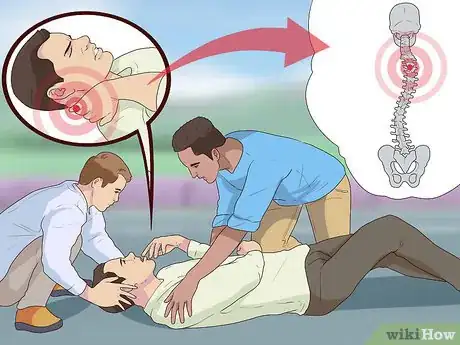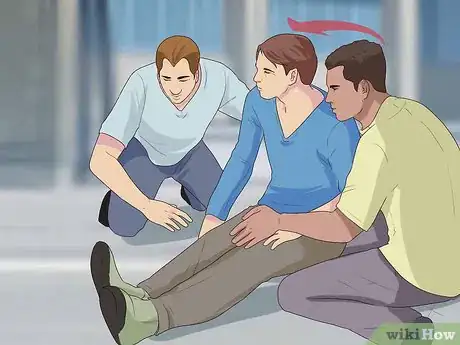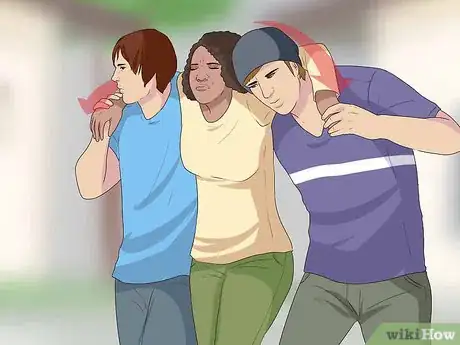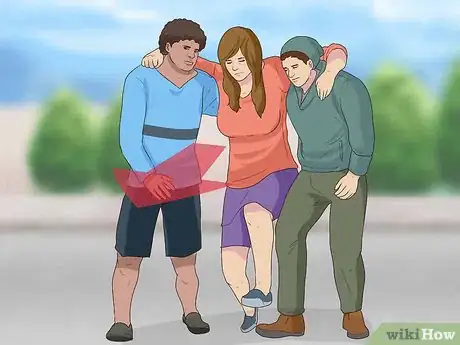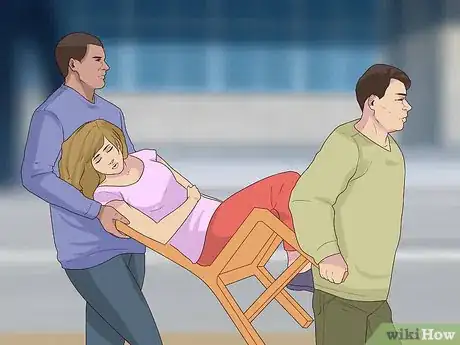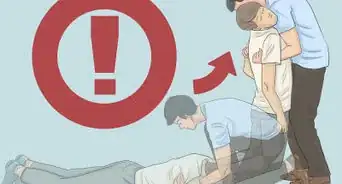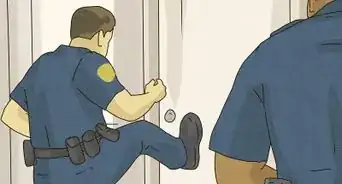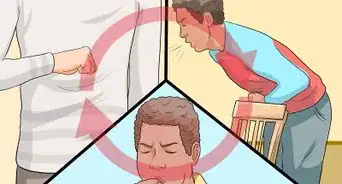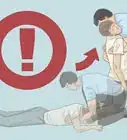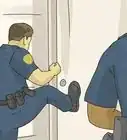This article was co-authored by Anthony Stark, EMR. Anthony Stark is a certified EMR (Emergency Medical Responder) in British Columbia, Canada. With over 11 years of experience, he has worked as an industrial medic and provided urban and rural paramedic services. He currently works for Mountain View Safety Services and previously worked for the British Columbia Ambulance Service. Anthony has a Bachelor of Engineering in Electrical, Electronics, and Communications Engineering from the Georgia Institute of Technology. He has completed the EMP Canada EMT Course and Swiftwater Awareness Training associated with the British Columbia Ambulance Service.
This article has been viewed 119,626 times.
If you are in a remote location or another situation in which someone is injured and there are little or no emergency services or first aid kits available, you may need to carry the person to safety or treatment. While this may seem daunting, if you have a second person with you, there are a variety of ways in which to carry the injured party if they are conscious or unconscious. By employing any of these different carries, you may help or even rescue someone with an injury. And remember to use proper lifting technique when picking up a wounded person — always lift with your legs, not your back.
Steps
Using the Human Crutch
-
1Check the person for neck and back injuries. Do not attempt to move anyone who may have a neck or spinal injury. Assume a head or neck injury if:
- The person complains of severe neck or back pain
- The injury has exerted substantial force on the back or head
- The person complains of weakness, numbness or paralysis or lacks control of his limbs, bladder or bowels
- The person's neck or back is twisted or positioned oddly
-
2Leave person on the ground to start. While you put yourself and the other person in the proper positions to utilize the human crutch, leave the injured party on the ground. This can help ensure that you don't drop or further injure the person while you shift yourselves into the proper technique.[1]Advertisement
-
3Put your bodies in the proper position. You and the other rescuer should stand on either side of the injured person's chest, facing each other.[2] Making sure you are in the proper position can help minimize the risk of dropping the person or injuring him further.
-
4Pull the person to a sitting position. Once you and your partner have a firm grasp of the injured person, pull her up into a sitting position. Make sure to do this slowly so that you don't accidentally jostle or lose grasp of the person.[5]
- Slowly lifting the person to a seated position can also give her circulatory system a chance to stabilize, especially if she's been lying on the ground. This can help prevent dizziness that may cause the person to fall.
- If she is conscious, you may want to verbally check in with the injured person to make sure that this doesn't cause her any pain or confirm that she is feeling stable.[6]
- Allow the person to sit at least for a couple of minutes before moving her to a standing position. At this point, instruct person you are going to move her to safety.
-
5Assist the injured person to his feet. Once the injured person is ready and able, help the person to stand up. If not, lift the person to his feet by grasping clothing items.[7]
- Give the person as much time as he needs to stand up, as long as there isn't any other immediate danger. As with sitting, this can help stabilize his blood pressure and help prevent unnecessary falls.[8]
- If the person is not able to place either a foot or both his feet on the ground, you may need to offer a little bit more support. Remove as much of the weight from his leg or legs as possible in this case.
-
6Wrap your hands around the injured person's waist. Once the person is standing, place your hands around the waist of the injured person. As you begin to move out the person, this can add an extra measure of security while assisting the person.[9]
- If the person is unconscious, grasp her belt or waistband. Pull on it slightly to lift the person's upper body.[10]
-
7Place the injured person's arms over your shoulder. Squat down slightly and put the person's arms over your shoulder and that of your fellow rescuer. This should place you in the same direction as the injured person.
-
8Move out with the injured person. Once everyone is standing and facing the same direction, you are ready to move out with the injured person. Make sure to check that the person is secure either by asking her or checking with your fellow rescuer if the person is unconscious. This can not only help ensure that you don't drop or jostle the person, but also help you more effectively remove the injured party from the situation.[13]
Employing Alternative Carries
-
1Improvise a stretcher to carry the injured person. If person is unconscious or unstable, make a stretcher to carry the person. You can use two poles or some blankets or improvise a stretcher out of whichever materials you have available.[16]
- Find two sturdy poles, tree branches or other straight pole-like objects and place them parallel on the ground.[17]
- Take a cloth roughly three times as big as the stretcher should be and lie it on the ground. Put a sturdy pole a third to half of the way along the cloth; fold the section over the pole.
- Set the other pole on the two pieces of cloth, leaving enough room for the injured person and enough cloth to fold over this second pole.
- Fold the cloth over the pole so that at least one foot of cloth encases the second pole. Take the rest of the cloth and fold it over your poles again.
- If you don't have a large cloth or blanket, use blankets, shirts, sweatshirts, or any other cloth you may have available. Do not give up your clothing if this will in any way hamper your ability to assist the person.[18]
- Check to make sure that the stretcher you've fashioned is as secure as possible so that you don't drop the person.[19]
-
2Fashion a stretcher using four hands. If you don't have the materials to create a stretcher, you can also fashion one using the hands of yourself and your fellow rescuer.[20] This can provide a more stable position to the person, especially if she is unconscious.[21]
- The person should be on the ground and the rescuer with his hand closest to the the injured person's head should place his hand under her head for support.
- Under the the injured person's chest, at about the level of the lower sternum, each rescuer should grasp for the hand of his fellow rescuer. The rescuers should then interlock their hands for a stable surface.[22]
- The rescuer with a hand closest to the injured person's feet should place his hand under her legs.[23]
- Squat down and gently lift the person and move her out.
-
3Carry the person with a chair. If it is available, use a chair to carry the injured person. This is an especially effective method if you and the other rescuer have to climb stairs or navigate narrow or uneven territory.[24]
- Either pick up the person and place him in the chair or have him sit in the chair if he is able.[25]
- The rescuer standing at the head of the chair should grasp the chair by the sides of the back with her palms facing in.[26]
- From here, the rescuer at the head can tilt the chair on to its rear legs.[27]
- The second rescuer should face the person and grasp the legs of the chair.[28]
- If you have a longer distance to cover, you and your rescuer should separate the person's legs and pick up the chair by squatting down and lifting.[29]
-
4Construct a chair with your hands. If a chair is not readily available to help your carrying efforts, you and your fellow rescuer can make a chair using your hands. Whether a two- or four-handed seat, you can effectively move the injured person with these seats.[30]
- A two-handed seat is most useful for carrying people longer distances or for supporting an unconscious person.[31]
- Squat down on either side of the person. Slide one arm under her shoulders, resting your hand on the shoulder of your partner. Slide your other arm under the knees of the person and grasp the other rescuer's wrists. Alternatively, you can both make a "hook" with your hands by curling your fingers in toward your palm, then hook your hands together.
- Lift up from squatting, lifting from your legs and keeping your back straight, and begin moving forward.[32]
- A four-handed seat is most useful for carrying those who are still conscious.[33]
- You and your fellow rescuer should grasp each other's wrists — he should grasp your left wrist with his right hand, and you should grasp your right wrist with your left hand. Your right hand should grasp his left wrist, and his left hand should grasp his right wrist.[34] Your hands should form a square shape when locked together in this configuration.
- Lower this seat to a height that allows the injured person to sit. Make sure to lower the seat using your legs and not your back to minimize your risk of injury and ensure stability.[35] Have the person drape her arms over your shoulders.
- Stand using your legs, keeping your back straight.
- A two-handed seat is most useful for carrying people longer distances or for supporting an unconscious person.[31]
Warnings
- Only move a person with a suspected head or spinal injury if absolutely necessary, such as to escape falling debris, fire or rising water. Stabilize his or her neck and spine as soon as it is safe.⧼thumbs_response⧽
Things You'll Need
- Chair (if applicable)
- Poles (if applicable)
- Blanket type material (if applicable)
References
- ↑ http://adminopsnet.usc.edu/sites/default/files/all_departments/FireSafetyEmergPlanning/CERTLiftsandCarries.pdf
- ↑ http://adminopsnet.usc.edu/sites/default/files/all_departments/FireSafetyEmergPlanning/CERTLiftsandCarries.pdf
- ↑ http://adminopsnet.usc.edu/sites/default/files/all_departments/FireSafetyEmergPlanning/CERTLiftsandCarries.pdf
- ↑ http://adminopsnet.usc.edu/sites/default/files/all_departments/FireSafetyEmergPlanning/CERTLiftsandCarries.pdf
- ↑ http://adminopsnet.usc.edu/sites/default/files/all_departments/FireSafetyEmergPlanning/CERTLiftsandCarries.pdf
- ↑ http://adminopsnet.usc.edu/sites/default/files/all_departments/FireSafetyEmergPlanning/CERTLiftsandCarries.pdf
- ↑ http://adminopsnet.usc.edu/sites/default/files/all_departments/FireSafetyEmergPlanning/CERTLiftsandCarries.pdf
- ↑ http://adminopsnet.usc.edu/sites/default/files/all_departments/FireSafetyEmergPlanning/CERTLiftsandCarries.pdf
- ↑ http://adminopsnet.usc.edu/sites/default/files/all_departments/FireSafetyEmergPlanning/CERTLiftsandCarries.pdf
- ↑ http://adminopsnet.usc.edu/sites/default/files/all_departments/FireSafetyEmergPlanning/CERTLiftsandCarries.pdf
- ↑ http://adminopsnet.usc.edu/sites/default/files/all_departments/FireSafetyEmergPlanning/CERTLiftsandCarries.pdf
- ↑ http://adminopsnet.usc.edu/sites/default/files/all_departments/FireSafetyEmergPlanning/CERTLiftsandCarries.pdf
- ↑ http://adminopsnet.usc.edu/sites/default/files/all_departments/FireSafetyEmergPlanning/CERTLiftsandCarries.pdf
- ↑ http://adminopsnet.usc.edu/sites/default/files/all_departments/FireSafetyEmergPlanning/CERTLiftsandCarries.pdf
- ↑ http://adminopsnet.usc.edu/sites/default/files/all_departments/FireSafetyEmergPlanning/CERTLiftsandCarries.pdf
- ↑ http://www.troop50.org/first_aid/04-moving_victims.shtml
- ↑ http://adminopsnet.usc.edu/sites/default/files/all_departments/FireSafetyEmergPlanning/CERTLiftsandCarries.pdf
- ↑ http://adminopsnet.usc.edu/sites/default/files/all_departments/FireSafetyEmergPlanning/CERTLiftsandCarries.pdf
- ↑ http://adminopsnet.usc.edu/sites/default/files/all_departments/FireSafetyEmergPlanning/CERTLiftsandCarries.pdf
- ↑ http://www.troop50.org/first_aid/04-moving_victims.shtml
- ↑ http://www.troop50.org/first_aid/04-moving_victims.shtml
- ↑ http://www.troop50.org/first_aid/04-moving_victims.shtml
- ↑ http://www.troop50.org/first_aid/04-moving_victims.shtml
- ↑ http://adminopsnet.usc.edu/sites/default/files/all_departments/FireSafetyEmergPlanning/CERTLiftsandCarries.pdf
- ↑ http://adminopsnet.usc.edu/sites/default/files/all_departments/FireSafetyEmergPlanning/CERTLiftsandCarries.pdf
- ↑ http://adminopsnet.usc.edu/sites/default/files/all_departments/FireSafetyEmergPlanning/CERTLiftsandCarries.pdf
- ↑ http://adminopsnet.usc.edu/sites/default/files/all_departments/FireSafetyEmergPlanning/CERTLiftsandCarries.pdf
- ↑ http://adminopsnet.usc.edu/sites/default/files/all_departments/FireSafetyEmergPlanning/CERTLiftsandCarries.pdf
- ↑ http://adminopsnet.usc.edu/sites/default/files/all_departments/FireSafetyEmergPlanning/CERTLiftsandCarries.pdf
- ↑ http://adminopsnet.usc.edu/sites/default/files/all_departments/FireSafetyEmergPlanning/CERTLiftsandCarries.pdf
- ↑ http://adminopsnet.usc.edu/sites/default/files/all_departments/FireSafetyEmergPlanning/CERTLiftsandCarries.pdf
- ↑ http://adminopsnet.usc.edu/sites/default/files/all_departments/FireSafetyEmergPlanning/CERTLiftsandCarries.pdf
- ↑ http://adminopsnet.usc.edu/sites/default/files/all_departments/FireSafetyEmergPlanning/CERTLiftsandCarries.pdf
- ↑ http://adminopsnet.usc.edu/sites/default/files/all_departments/FireSafetyEmergPlanning/CERTLiftsandCarries.pdf
- ↑ http://adminopsnet.usc.edu/sites/default/files/all_departments/FireSafetyEmergPlanning/CERTLiftsandCarries.pdf
